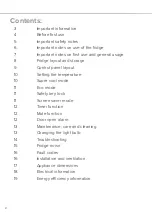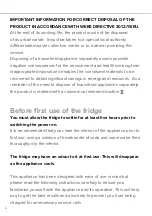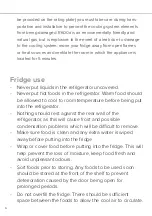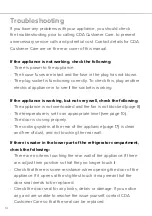
15
If ice/frost has formed on the back wall of the fridge;
•
It is normal for some ice droplets and/or frost to form on the back
wall of the fridge. This does not constitute a fault with the appliance.
•
Ensure that no items inside the fridge are in contact with the back
wall.
•
Carry out the door seal checks mentioned in the previous
troubleshooting point.
If the appliance is noisy, check the following;
•
The appliance is level and stable. The side, underside and rear
walls are clear, and there is nothing resting on the appliance.
•
It is normal to hear the compressor running. This will operate
periodically and more so when the appliance door is opened.
•
The appliance may make what seem to be peculiar noises, even
when the compressor is not running:
Cracking noise, similar to ice cracking
- Normal noise that can occur
when the appliance is cooling or warming. Due to the expansion and
contraction of appliance materials.
Loud click
- Normal noise and is usually the thermostat switching the
compressor on or off.
Ticking sound
- Normal noise that is usually caused by the functions
of a valve at the back of the refrigerator.
Motor sound
- Normal noise caused by the compressor running,
sometimes accompanied by a brief metallic rattle. This sound may be
more intense for the first seconds after the compressor starts. If the
metallic noise (i.e. metal hitting metal) is constant then it may be that a
compressor mount is loose.
Bubbling noise
- Normal noise caused by the movement of the
refrigerant within the appliance’s pipework.






































